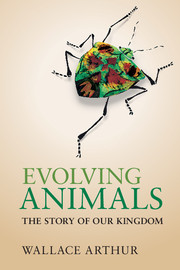Book contents
- Frontmatter
- Dedication
- Contents
- Preface
- Acknowledgements
- 1 What is an animal?
- 2 Before there were animals
- 3 How to make a fossil
- 4 The Cambrian explosion
- 5 How to make a species
- 6 Jellyfish and their kin
- 7 How to make a tree
- 8 The enigmatic urbilaterian
- 9 Animal symmetry and heads
- 10 A plethora of worms
- 11 Trends in animal complexity
- 12 Where the octopus is king
- 13 How to make an animal
- 14 Exoskeletons galore
- 15 Extinction
- 16 Mouth first, mouth second
- 17 Comparing embryos
- 18 Larvae, mouthparts and moulting
- 19 The animal toolkit
- 20 Vertebrate origins and evolution
- 21 From water to land to water
- 22 Variation and inheritance
- 23 Evolutionary novelties
- 24 Human origins and evolution
- 25 Animal plasticity
- 26 The nature of adaptation
- 27 The direction of evolution
- 28 Animal extremophiles
- 29 Extraterrestrial animals?
- 30 The ghost in the machine
- Appendix
- References
- Index
26 - The nature of adaptation
Published online by Cambridge University Press: 05 August 2014
- Frontmatter
- Dedication
- Contents
- Preface
- Acknowledgements
- 1 What is an animal?
- 2 Before there were animals
- 3 How to make a fossil
- 4 The Cambrian explosion
- 5 How to make a species
- 6 Jellyfish and their kin
- 7 How to make a tree
- 8 The enigmatic urbilaterian
- 9 Animal symmetry and heads
- 10 A plethora of worms
- 11 Trends in animal complexity
- 12 Where the octopus is king
- 13 How to make an animal
- 14 Exoskeletons galore
- 15 Extinction
- 16 Mouth first, mouth second
- 17 Comparing embryos
- 18 Larvae, mouthparts and moulting
- 19 The animal toolkit
- 20 Vertebrate origins and evolution
- 21 From water to land to water
- 22 Variation and inheritance
- 23 Evolutionary novelties
- 24 Human origins and evolution
- 25 Animal plasticity
- 26 The nature of adaptation
- 27 The direction of evolution
- 28 Animal extremophiles
- 29 Extraterrestrial animals?
- 30 The ghost in the machine
- Appendix
- References
- Index
Summary
Evolutionary concepts in general can be thought of as being primarily related to pattern in some cases and process in others. Darwinian natural selection can be considered to be the key concept related to process. With regard to pattern, the key concept can probably be said to be homology. Ironically, this term was invented by English anatomist Richard Owen in the 1840s, before publication of On the Origin of Species and without an explicit evolutionary interpretation. Owen recognized as homologies similarities that were in some sense true ones, despite obvious differences in form, such as the arm of a human and the wing of a bird (Figure 26.1). Others that were not thought to be true ones were not considered homologous but merely analogous – such as the tail of a salmon and that of a dolphin.
It soon became apparent, though, that what Owen was recognizing as homologies were structures that had a common ancestral form – the foreleg of an early land vertebrate in the case of the human arm and the avian wing. In contrast, similar but non-homologous structures arose convergently. A dolphin’s tail arose as a novel structure when one lineage of mammals became aquatic. It is homologous to the tails of related mammals, notably whales, but not to the tails of fish.
- Type
- Chapter
- Information
- Evolving AnimalsThe Story of our Kingdom, pp. 262 - 273Publisher: Cambridge University PressPrint publication year: 2014



